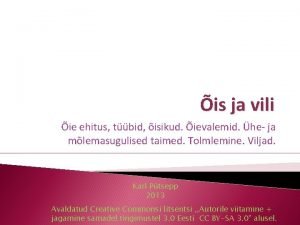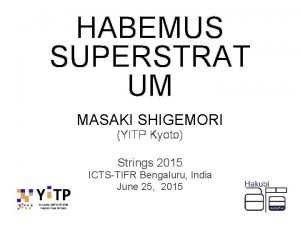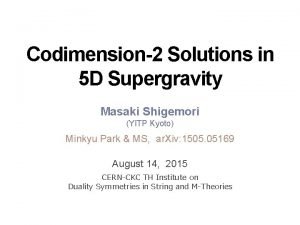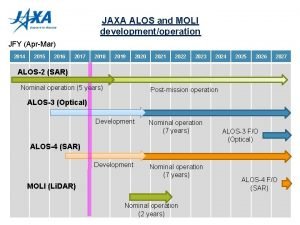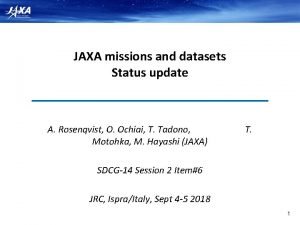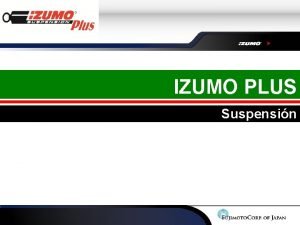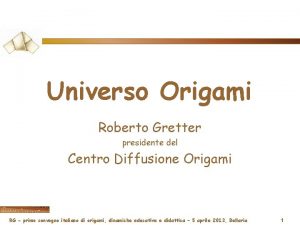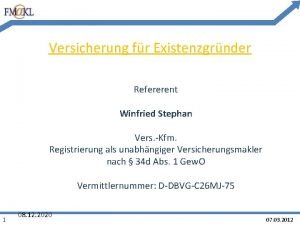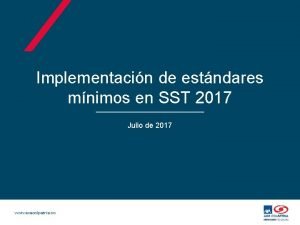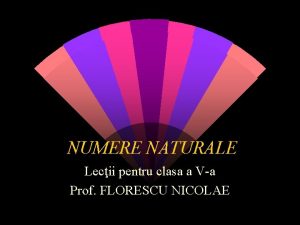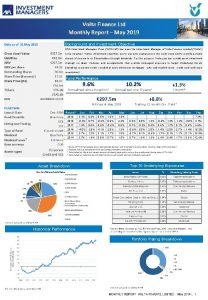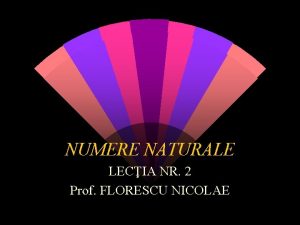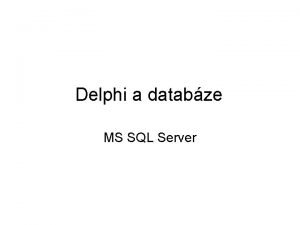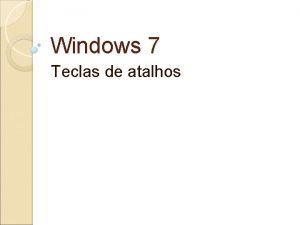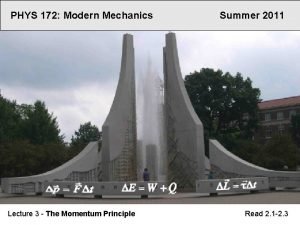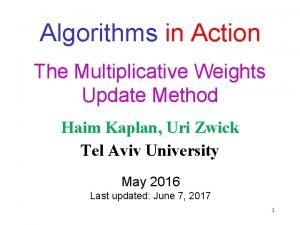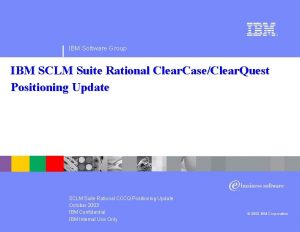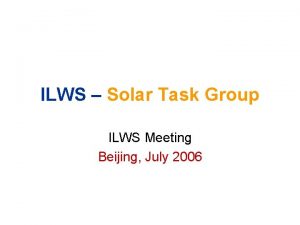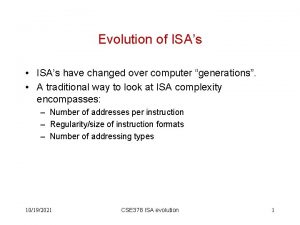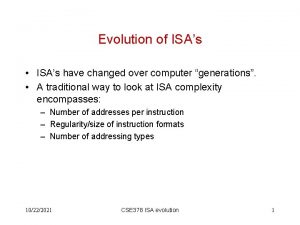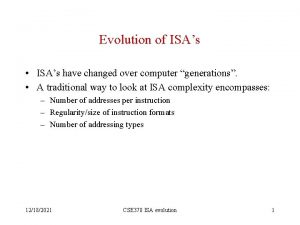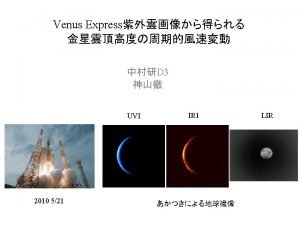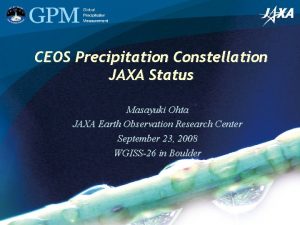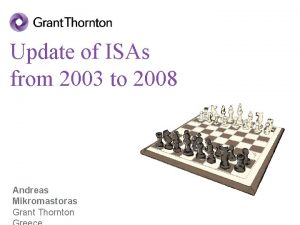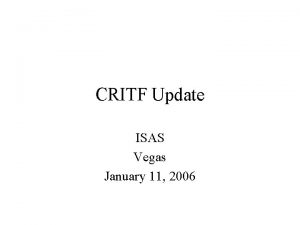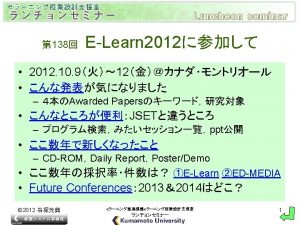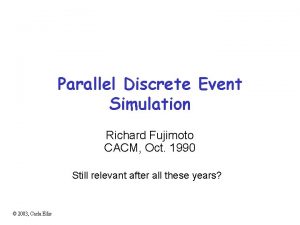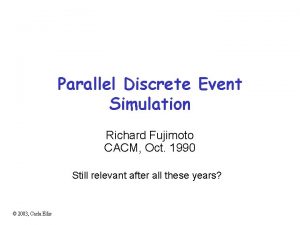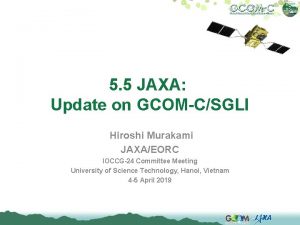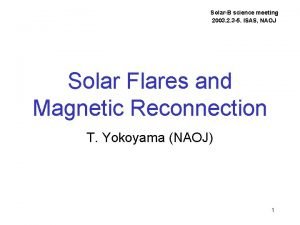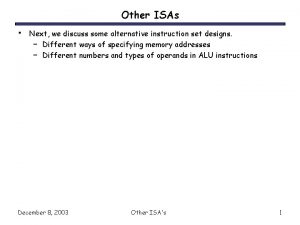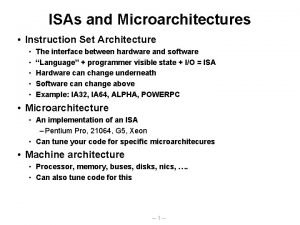JAXA Update Masaki Fujimoto ISAS j AXA ILWS
















































- Slides: 48

JAXA Update Masaki Fujimoto ISAS, j. AXA ILWS Prague 08

Contents • Magnetospheric - Ongoing: Geotail, Kaguya - Future: Bepi. Colombo MMO, ERG, SCOPE/Cross-Scale, EJSM JMO • Solar - Ongoing: Hinode - Future : Solar-C

08 10 15 20 year GT(L 92) Kaguya(L 07) ERG MMO(Launch)---------------MMO(Arrival) SCOPE/Cross-Scale EJSM-JMO Hinode(L 06) Solar-C

Magnetospheric, on-going: GT

Geotail Launched in 1992 as a US-Japanese joint mission Now contributing unique measurements to the Heliophysics Great Observatory Instruments (E and B Fields, Waves and Particles): All in good condition after 16 years in space

Geotail covers virtually every region in geospace In its unique 9 X 30 Re equatorial orbit • Covers all regions of the outer magnetosphere • Multipoint measurements – particularly with THEMIS • Near Earth Upstream Monitor

An excellent spatio-temporal picture is provided by the Geotail/THEMIS coverage in the near-mid tail region • Near-tail and mid-tail dynamics are highly coupled • Observations by THEMIS’s inner-three probes are more valuable when simultaneous mid-tail observations are available • If THEMIS’s outer-two probes transfer to lunar orbit, Geotail will be the only spacecraft to observe the mid -tail dynamics.

Japanese Extension Review & NASA Senior Review Canadian Space Agency University of Alberta University of Calgary Finnish Meteorological Institute Swedish Institute of Space Physics (IRF) International Association of Geomagnetism and Aeronomy (IAGA) • Thanks to the international community’s supports, Russian Academy of Science St. Petersburg State University Geotail operation extension Chinese Academy of Science (through 2012 (ISAS/JAXA) and 2010 (NASA)) Peking University was approved! Wuhan University NASA/GSFC European Space Agency (ESA) University of New Hampshire Imperial College London National Chen-Kung University Boston University Technical University of Braunschweig Applied Physics Laboratory (APL/JHU) Austrian Academy of Science University of Colorado Istituto di Fisica dello Spazio Interplnetario (INAF) NOAA National Observatory of Athens Southwest Research Institute Centre d’Etude Spatiale des Rayonnements (CESR) University of California, Berkeley University of California, Los Angels Australian Academy of Science Lockheed Martin Advanced Technology Center • International research leaders submitted 40 letters supporting Geotail and all mentioned Geotail-THEMIS conjunction. • Geotail-THEMIS conjunction was one of the issues that were scored highly by both review committes.

Japanese Geotail-ers Serious about the Heliosphysics Great Observatory concept • Conjunction Event Finder http: //darts. isas. jaxa. jp/stp/cef. cgi • Web tool for any researcher to make instant access to research quality plots from various s/c • Developed and maintained at ISAS

• The JP community will stay alive and kicking during the multi-spacecraft observation era led by THEMIS, for which we have been dreaming a long time.

Magnetospheric, on-going: Kaguya, formerly known as SELENE, a Japanese mission the Moon to

©JAXA

KAGUYA MAP-PACE Science Objectives Observtaion of ions originating from lunar atmosphere / lunar surface Observation of magnetic anomaly with electron reflectometer ESA-S 1 electron energy spectra FOV :hemisphere energy : 5 e. V-10 ke. V IEA-S ion energy spectra FOV :hemisphere energy : 5 e. V/q-28 ke. V/q ESA-S 2 electron energy spectra FOV :hemisphere energy : 5 e. V-15 ke. V IMA-S ion energy mass spectra FOV :hemisphere energy : 5 e. V/q-28 ke. V/q mass : 1 -60 mass resolution : 15 (max. ) (from the Moon) (to the Moon) (from the Moon)

Ions of Lunar-origin detected for the first time count MAP-PACE-IMA detected alkali ions Time Of Flight (nsec)

ESA-S 2 ESA-S 1 IEA observed solar wind IEA IMA Solar wind reflection LMAG Pick up acceleration of reflected solar wind

• The solid surface-plasma interaction is indeed very interesting, much more than we had thought. A very encouraging finding for Bepi. Colombo MMO to Mercury.

Magnetospheric, future: ERG A PI-led small spacecraft mission to the inner-magnetosphere

ERG ---Energization and Radiation in Geospace A mission to elucidate acceleration and loss mechanisms of relativistic particles in the inner magnetosphere during space storms. During space storms, Geospace acts as an effective accelerator of electrons and ions, and dynamic variation of Geospace causes various “space weather” phenomena. ERG mission will achieve comprehensive plasma observations with magnetic & electric field, wave, and particle detectors covering a wide energy coverage (1 -107 e. V) to capture acceleration, transport, and loss of particles in Geospace around the next solar maximum.

Mission Outline Launch: FY 2012 (around next solar maximum) Orbit: Apogee: 5. 5 -6. 0 Re / Perigee: ~300 km Low Inclination (TBD) Science Instruments: electron detectors (1 -107 e. V) ion detectors with mass discrimination (1 -106 e. V) Target : radiation belts, ring current, plasma sheet, plasmasphere DC/AC magnetic & electric fields Target: convective electric field, ULF pulsation, EMIC, whistler

International Collaboration within ILWS The next solar maximum is invaluable period for the Geospace science by international multi-satellites. International collaborations at various levels (science team collaborations and/or exchange, data product collaboration, orbit planning, etc. ) between ERG (ISAS), RBSP (NASA) and ORBITALS (CSA) are essential for understanding particle accelerations and losses that depend on radial distance and local time. RBSP ERG ORBITALS From RBSP homepage

• ERG will be proposed to the small-spacecraft program this year (due date: Sep 30). • The stringent cost-cap allocated for a mission in the line of the small spacecraft program will oblige PI (Prof. T Ono, Tohoku U) to come up with descope plan and/or international collaboration scheme.

Magnetospheric, future: SCOPE/Cross-Scale Simultaneous multi-scale measurements of plasma dynamics in the natural laboratory of the Earth’s magnetosphere The Plasma Universe theme

The Plasma Universe • Large portion of the Universe filled by plasma gas • Growing interest in plasma (magnetic) effects in broader space science community • Attraction in explosive phenomena that develop in space plasmas • Curious behavior that cannot be predicted by the everyday common-sense The most fundamental feature of space plasmas: High degrees of freedom, which originates in dynamical coupling among instabilities that develop at various scales: Cross-Scale Coupling

Towards fundamental understanding of the Plasma Universe • Need to unveil how cross-scale coupling operates in space plasmas • Detailed information from dedicated in-situ measurements will contribute significantly

The new direction in earth/planetary magnetospheric missions • In-situ measurements up to the particle data level can offer what are needed for the fundamental understanding of space plasma physics – unveiling the cross-scale coupling in space plasmas. • Only magnetospheric missions can provide such detailed information, which is crucial for the Plasma Universe research. • The new perspective to look at the magnetospheres as the laboratories of space plasma dynamics and to revitalize the value of magnetospheric observations is being widely accepted.

Cross Scale Coupling MHD-scale dynamics Addition of curious Large-scale Dynamic effects Non-MHD processes add interesting Non-linear phenomenon develops effects unreachable MHD dynamics effects onlyby when the system works as a whole Key process in key region Boundary condition In most cases, ion/electron scale physics

Multi-scale measurements is visualization • Good visualization - Large field-of-view Coverage over the MHD-scale dynamics - High resolution image Resolving electron-scale dynamics

Daughter(far): 5 km 〜 5000 km MHD Scale Daughter(far) Daughter(near): 5 km 〜 100km Electron Scale Mother Ultra high-speed electron measurements Daughter(far) SCOPE Daughter(far)

JAXA SCOPE A big mothership (P/L ~90 kg) ESA M-Cube Tetrahedra at 3 -scales, with each s/c being rather simple

Combing the two ideas in the ideal way gives birth to Cross Scale

The whole picture of SCOPE/Cross -Scale: Full-scale coverage via international collaboration with clear interfaces ESA’s component To be launched by JAXA’s H 2 -A SCOPE mother and near-daughter Far-daughters (JP) (CAN) Dual launch partner THEMIS-like s/c (NASA) China’s component Russia’s component

• SCOPE will be proposed at ISAS this September. • Solid ideas on the collaboration scheme (especially CAN and US) will help SCOPE to be successful at the review. • SCOPE’s moving to the next stage should help others to move on. • This is nothing but win-win relationship!

Magnetospheric, future: Bepi. Colombo MMO EJSM JMO Bepi. Colombo MMO: To Mercury, together with MPO, two-point measurements in the mysterious “kinetic” magnetosphere EJSM JMO: To Jupiter, together with EO and JGO, three-point meassurements in the most astro-like magnetophere of the solar system

Future Space Plasma Missions at JAXA ~2020’s Planetary Magnetospheres The Plasma Universe Geospace Exploration SCOPE/Cross. Scale ESA/JAXA Multiscale at the same time in Earth magnetosphere ~2017 ESA/JAXA mission to Jupiter in 2020’s (with ESA and NASA) Bepi. Colmbo L 2014 ESA/JAXA mission to Mercury ERG A small explorer into the inner-magnetosphere and relativistic particle acceleration processes ~2011

Three steps towards the new horizon • SCOPE/Cross. Scale: Setting the new backbone of space plasma physics • Bepi. Colombo MMO: Exploration into the mysterious micro-cosmos • Mission to Jupiter: Anatomy of the huge particle accelerator • These three steps via international collaboration will transform space plasma physics into a new shape. • It’s not just about the magnetosphere anymore.

Solar, ongoing: Hinode

Solar Physics Satellite Hinode Solar Optical Telescope (SOT) EUV Imaging Spectrometer (EIS) 0. 2 arcsec observations of magnetic and velocity fields at the solar surface with LM and NASA with NASA (technical advice/support, tracking support) Extensive internaltional collaboration with U. S. , U. K. , and with ESA Diagnostics of the coronal thermal properties and dynamics by EUV spectroscopy with MSSL, RAL, NRL, PPARC, and NASA with SAO and NASA X-Ray Telescope (XRT) High resolution imaging of the 1 -10 MK corona – The third Japanese solar physics satellite, following Hinotori and Yohkoh. – Investigate photospheric magnetic activities and their corresponding coronal bahavior. via simultaneous observations of the photosphere and the corona. – Launched on 22 September 2006 UT, with M-V-7 vehicle. Started observation from late October in that year, and continuing observation of the Sun since then.

Hinode (Solar-B) Launched on September 23, 2006 JST. Hinode observes the Sun with high spatial resolution in optical, EUV, and X-ray wavelengths. Solar Optical Telescope(SOT) Dynamical upward flows of the gas on the solar limb (SOT) EUV Imaging Spectrometer (EIS) X-Ray Telescope( XRT) X-ray morphology of a major flare (left)pre-flare corona (right)flare explosion X-ray jets at the polar region X-ray coronal image of the full Sun (XRT) Fine structures of sunspot (SOT) Solar granules: Hinode (left) has great advantage to stable high spatial observations, compared with best seeing site on the ground (right)

Initial results from Hinode • Initial results have been published as special issues in refereed journals – “Publications of Astronomical Society of Japan” • 43 papers published in 30 November issue – “Science” • 9 papers published in 7 December issue – European “Astronomy and Astrophysics” • 19 papers published in 1 April issue – “Solar Physics” (journal for solar and solar-terrestrial research) • Total 9 papers for describing instruments • Volume 1, published on June 2007 • Volume 2, coming soon – Others • 16+ papers in US “Astrophysical Journal” Total 91 Papers in FY 2007

• X-band has failed but back-up by S-band, with the help from international communities, is saving the science of Hinode.

Solar, future: Solar-C

Japanese Space Solar Physics towards Solar-C Yohkoh/SOLAR-A(1991– 2001) Hinotori/ASTRO-A(1981– 1982) Hinode/SOLAR-B(2006–) Next Solar Mission SOLAR-C Mid. 2010 s

Two SOLAR-C Mission Concepts Under Study • Plan A Out-of-ecliptic magnetic/X-ray and helioseismic observations of the polar and the equatorial regions to investigate properties of the polar region, meridional flow and magnetic structure inside the Sun down to the bottom of the convection zone. • Plan B High spatial resolution, high throughput, high cadence spectroscopic (polarimetric) and X-ray observations seamlessly from photosphere to corona to investigate magnetism of the Sun and its role in heating and dynamism of solar atmosphere. • Launch Date: Japanese fiscal year 2016 (provisional) – Expects joint observations with highly complementary missions – NASA SDO (whole sun field of view) – ESA&NASA Solar Orbiter (In-situ and stereo obs with SOLAR-C)

Development of SOLAR-C Concept • JAXA SOLAR-C WG refines both plans, compare science, technology, and other constraints, and prioritize the two plans with international partners. * International SOLAR-C science definition meeting planned at ISAS/JAXA in the week of 10 Nov. this year. • Japanese solar physics community recognize that success of Hinode and Yohkoh is due to strong international support. • Solar physics community and related-disciplines in Japan strongly desire and endorse one of the SOLAR-C mission concept to be realized in mid-2010 s. • JAXA SOLAR-C working group invites US and European participation to the SOLAR-C program, following our remarkable history of collaboration.

• Need your input!

Recap • Magnetospheric - Ongoing: Geotail, Kaguya - Future: Bepi. Colombo MMO, ERG, SCOPE/Cross -Scale, EJSM JMO • Solar - Ongoing: Hinode - Future : Solar-C

08 10 15 20 GT(L 92) Kaguya(L 07) ERG MMO(Launch)---------------MMO(Arrival) SCOPE/Cross-Scale EJSM-JMO Hinode(L 06) Solar-C

• It is obvious that we rely on international collaborations in these future programs.
 Isa vetting and barring
Isa vetting and barring Isasõite kogum
Isasõite kogum Masaki shigemori
Masaki shigemori What is isas exe
What is isas exe Masaki kawase
Masaki kawase Nene masaki
Nene masaki Masaki shigemori
Masaki shigemori Jaxa małachowski
Jaxa małachowski Moli jaxa
Moli jaxa Calbaration
Calbaration Is an alternative of log based recovery.
Is an alternative of log based recovery. Musashino library sou fujimoto
Musashino library sou fujimoto Fujimoto japan
Fujimoto japan House k sou fujimoto
House k sou fujimoto Shuzo fujimoto
Shuzo fujimoto Winfried stephan
Winfried stephan Radar axa colpatria
Radar axa colpatria Suma a 6 numere naturale pare distincte este 30
Suma a 6 numere naturale pare distincte este 30 Axa investment manager paris
Axa investment manager paris Simetria fata de o dreapta
Simetria fata de o dreapta Axa mrh
Axa mrh Axa vision
Axa vision Axa ransomware
Axa ransomware Debeka tarif bc abgelehnt
Debeka tarif bc abgelehnt Axa assistance panama canal area benefit plan
Axa assistance panama canal area benefit plan Axa bcr
Axa bcr Willensmangel
Willensmangel Pe axa numerele mai mari sunt așezate mai mici
Pe axa numerele mai mari sunt așezate mai mici Bankhead primary
Bankhead primary Delphi sql update
Delphi sql update Database recovery techniques
Database recovery techniques Ocean freight market update dhl
Ocean freight market update dhl Update cmp
Update cmp Texas 811 update ticket
Texas 811 update ticket Game loop diagram
Game loop diagram Atalhos teclado windows 7
Atalhos teclado windows 7 Deferred update
Deferred update Position update formula
Position update formula Multiplicative weights update algorithm
Multiplicative weights update algorithm Contoh lost update problem
Contoh lost update problem Section 508 refresh
Section 508 refresh Windws update
Windws update Sql insert update delete query
Sql insert update delete query @microsoft/mgt
@microsoft/mgt Rational clear case
Rational clear case Database commit is triggered by
Database commit is triggered by Gtcs professional update
Gtcs professional update Igel download firmware
Igel download firmware Mdh situation update
Mdh situation update

